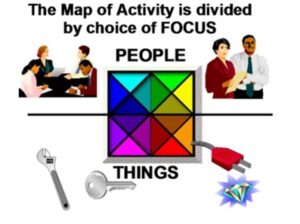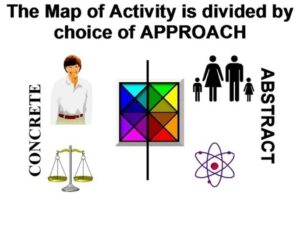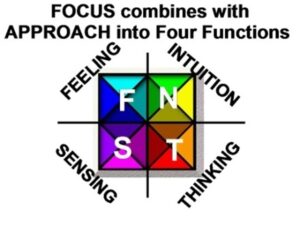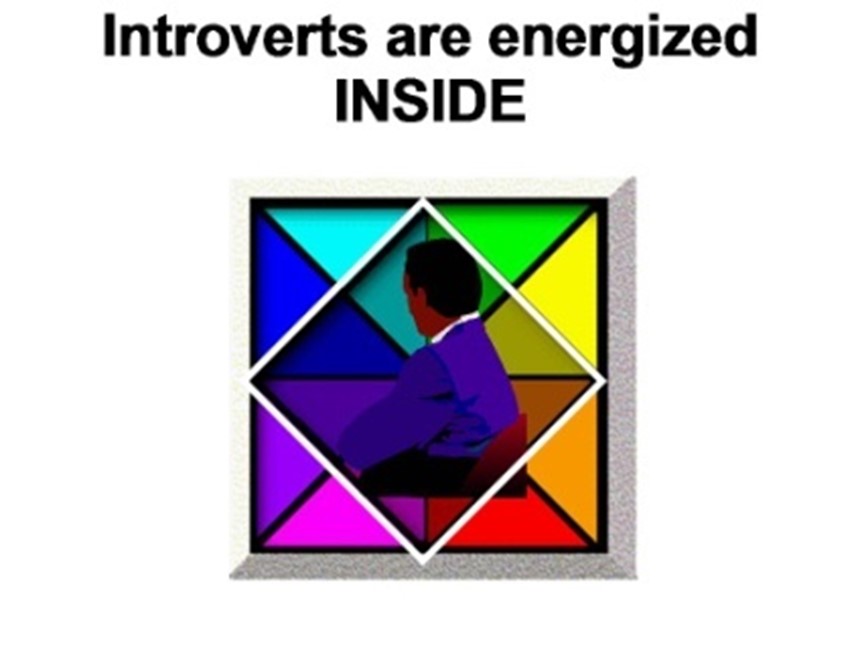
This post is about How to Understand People Part 3: OUTPUT. By using simple diagrams I have made complex information easy to understand. However, it might not make sense without the foundation already explained. This is the third article in my series How to understand people. If you have not already read parts 1 & 2, you might want to do so before continuing.
. 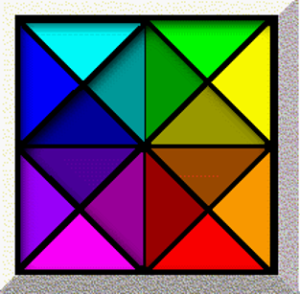 <click here to go to Part 1
<click here to go to Part 1
Let’s take time for a quick review. The colored square in the diagram is called The Map of Activities. It is divided top and bottom by the simple choice called FOCUS. On the top are PEOPLE and on the bottom are THINGS.
The diagram is divided left and right by the simple choice of APPROACH. On the left is CONCRETE and on the right is ABSTRACT.
The letters S,F,N & T stand for the four FUNCTIONS of SENSING, FEELING, INTUITION, and THINKING. The combination of the first two choices of FOCUS and APPROACH is what makes for the choices of FUNCTIONS.
- FEELING chooses CONCRETE PEOPLE
- INTUITION chooses ABSTRACT PEOPLE
- SENSING chooses CONCRETE THINGS
- THINKING chooses ABSTRACT THINGS.
This article will explain how two FUNCTIONS combine to create the activities of WORDS, IDEAS, HANDS, and BODY. It will also explain the concepts of INTROVERSION and EXTROVERSION

- First notice on the Map of Activities that the inside triangles are separated from the outside ones by a white square. Inside the square represents INTROVERSION. Outside the square represents EXTROVERSION. As the graphic label suggests this choice is about how we choose to find ENERGY for living.
INTROVERTED FUNCTIONS are energized from the inside out.
Introverts think internally. Ask an introvert a question and you are liable to get silence. When they do speak, they are not thinking out loud. You are getting the final results of their thinking. You can often tell extroverts from introverts by how they choose to interact in social settings. Introverts are often the last to arrive and the first to leave. When at a gathering they Might be a wallflower, or only talk to one or two people.
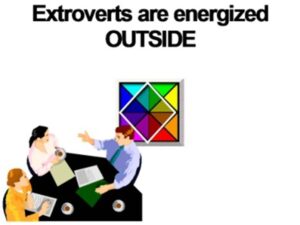
EXTROVERTED FUNCTIONS are energized from the OUTSIDE in. I’m an extrovert and this is so true for me. It seems I can’t think without speaking or writing something out there in the world. I often say or think, “Hey, I don’t know it’s stupid until I hear myself say it.” Extroverts need time everyday out and about in the world with the FOCUS of choice, PEOPLE or THINGS. In social functions they are often the first to arrive in the last to leave. These are the people who work the crowd.
If you are an extrovert, and your partner or significant other, is an introvert, follow this advice when having a discussion. Bring up your topic and then suggest that you might discuss it at sometime in the future. This gives the introvert time to quietly think over the subject then they’ll be ready to talk with you. If you are an introvert and want to talk with your extroverted partner or significant other, be sure you have thought through the subject before introducing the discussion. Once you have brought up the subject, be ready for the extrovert to begin talking almost immediately..

There are four sub activities in each of the areas on the Map of Activities. There are two each for EXTROVERTION and INTROVERSION. In subsequent articles we will look at all 16.
ACTIVITIES on the map.
For now understand that WORDS are made up of ENF and INF ( that is to say extroverted and introverted intuitive feeling) activities; IDEAS include ENT and INT (extroverted and introverted intuitive thinking) activities; HANDS include EST and IST (extroverted and intuitive, sensing thinkingj activities; and BODY includes ESF and ISF(extroverted and introverted sensing feeling) activities. In future posts, we will discuss in detail the kinds of activities that fall into each of these four categories of words, ideas, hands, and body.
Consider how these concepts are true in your life and in the lives of people you know. How do you use numbers. Where is your attention when it comes to times? What is most meaningful to you: having fun, belonging, discovering meaning in life, or understanding history? Look for the next installment of How to understand people Part 4: Dealing with the world. In it we will learn how to understand the choice between gathering data and making decisions.
